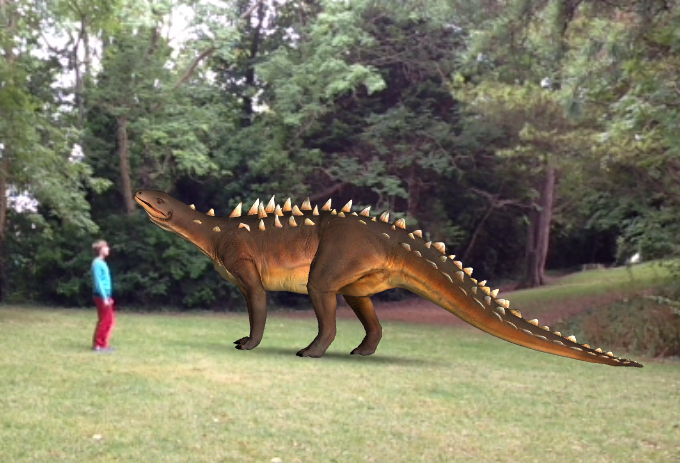Augmented reality? AR in your maintenance tool box
I’ve written several articles on VR that mentioned AR, but didn’t expand on what it could do. This shorter article summarises some of the possibilities.
Compiled in 2022, with links updated in June 2023. For my articles on VR see Virtually perfect, Alternative Realities and Feeling the heat.
What is Augmented reality?

Our family never got involved in the Pokémon GO craze. But when augmented reality gave us the chance to chase dinosaurs around the Isle of Wight, or pet them in a park in Suffolk, we sat up and paid attention. Immediately, I can see there could be some useful applications in health and safety.
What makes AR a very different experience from VR in that you can still see the real world around you. Hence, it is also referred to as “Mixed reality”. Just as the Pokémon creatures or dinosaurs could “appear” to be walking on a real pavement in front of you, so AR can be used to overlay safety-related information on a workplace when viewed through a mobile device such as a tablet, or through special glasses. Existing products include Vuzix smart glasses, Epson’s Moverio range, Microsoft HoloLens, RealWear and an enterprise version of Google Glass, a product that didn’t succeed as a consumer product (and will be withdrawn by the end of 2023).
In March 2023, Meta promised AR glasses for 2027, while in June 2023 Apple promised the Apple Vision Pro for 2024.
Use case examples
In relation to health and safety, the example applications for augmented reality tend to be focused around maintenance. Lack of maintenance, or errors during maintenance, have been shown to be a factor in many accidents. These can result from lack of expertise, communication failures on handover, or being unaware of the significance of alerts and equipment readings. Some applications for AR that could improve safety include:
- When given the choice between wading through a paper manual, and winging it based on training, most technicians I’ve worked with will do the latter. If instructions were triggered by being near a piece of equipment, and presented one step at a time, they would be more likely to follow those instructions. Incorporating voice commands, where the user can request the next instruction, or has to answer a question before proceeding (like “which colour light can you see?”) makes correct maintenance procedures more likely, particularly for periodic tasks like an annual service.
- Status information (temperatures, pressures, speeds, volumes, valve opening status) can be displayed next to each component in a plant room.
- While you might miss an alert on your smart phone, a red flashing light in front of your eyes would be hard to ignore, so AR could provide an alarm when something needs an urgent response.
- Some advanced glasses can measure and overlay temperature readings as the user moves their head, so they can see where equipment might be hotter.
- If a technician needs additional support, “see what I see” systems such as Skylight enable images to be shared with a support function located remotely from the workplace. Communication systems built into the goggles allow support staff to talk the technician through any difficulties.
Training
Although fewer examples are available of AR being used for training, it is easy to imagine a few:
- The same step-by-step instructions provided for maintenance could be used to practice a process using a digital twin – that is, a model that replicates the behaviour of the real system, and provides an idea of how the real system would respond to steps the trainee makes.
- An AR system that responds to where you are in a building could be used to provide an induction walk around for a worker, with the locations of important equipment (first aid kits, fire alarm call points) highlighted, exit routes explained, and even the door to the health and safety manager pin-pointed.
- Presenting models of equipment, which can be expanded or viewed with “X-ray” vision images overlaid on equipment. This would allow the use to see the schematics for complex systems, or strip away layers of components to see what lies underneath, to learn how they work.
Barriers to implementation
The buzz around new ways of applying AR is exciting, but we must keep our eyes on the goal – safer and healthier workplaces. Here then are a few questions we should ask as this technology develops.
- Can AR be safely incorporated into existing PPE? Heavy helmets could increase musculoskeletal pain, and clumsy gloves reduce dexterity.
- What does AR do to situational awareness? Will it enhance it with system information – or distract users from the hole in the floor they’re about to step into?
- If AR encourages people to follow a step-by-step approach for procedures, will they maintain the ability to improvise appropriately in novel situations?
- Will the technology be inclusive? Many existing headsets can be worn over spectacles, but Apple have already announced that to wear the Apple Vision Pro glasses wearers will either need contact lenses, or bespoke lenses that can be slotted into the headset.
Where is AR going?
There are products out there, but as I outlined in a LinkedIn article in 2023, I think we’re still waiting for the ‘killer app’ that will advance AR sufficiently for prices to come within the reach of health and safety departments.
